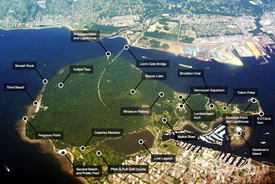| Stanley Park | |
|---|---|
 Aerial view of Stanley Park | |
 | |
| Type | Urban park |
| Location | Vancouver, British Columbia, Canada |
| Coordinates | 49°18′N 123°08′W / 49.30°N 123.14°W |
| Area | 404.9 hectares (4.049 km2; 1,001 acres; 1.563 sq mi) |
| Created | 1888 |
| Operated by | Vancouver Park Board |
| Visitors | approx. 8 million annually[1] |
| Website | vancouver |
| Official name | Stanley Park National Historic Site of Canada |
| Designated | 1988 |

Stanley Park is a 405-hectare (1,001-acre) public park in British Columbia, Canada, that makes up the northwestern half of Vancouver's Downtown peninsula, surrounded by waters of Burrard Inlet and English Bay. The park borders the neighbourhoods of West End and Coal Harbour to its southeast, and is connected to the North Shore via the Lions Gate Bridge. The historic lighthouse on Brockton Point marks the park's easternmost point. While it is not the largest urban park, Stanley Park is about one-fifth larger than New York City's 340-hectare (840-acre) Central Park and almost half the size of London's 960-hectare (2,360-acre) Richmond Park.[2]
Stanley Park has a long history. The land was originally used by Indigenous peoples for thousands of years before British Columbia was colonized by the British during the 1858 Fraser Canyon Gold Rush and was one of the first areas to be explored in the city. For many years after colonization, the future park, with its abundant resources, would also be home to non-Indigenous settlers. The land was later turned into Vancouver's first park when the city incorporated in 1886. It was named after Lord Stanley, 16th Earl of Derby, a British politician who had recently been appointed Governor General of Canada. It was originally known as Coal Peninsula and was set aside for military fortifications to guard the entrance to Vancouver harbour. In 1886, Vancouver City Council successfully sought a lease of the park which was granted for $1 per year. In September 1888, Lord Stanley opened the park in his name.[3]: 254
Unlike other large urban parks, Stanley Park is not the creation of a landscape architect but rather the evolution of a forest and urban space over many years.[4] Most of the manmade structures present in the park were built between 1911 and 1937 under the influence of then-superintendent W.S. Rawlings. Additional attractions, such as a polar bear exhibit, aquarium, and a miniature train, were added in the post–World War II period.
Much of the park remains as densely forested as it was in the late 1800s, with about a half million trees, some of which stand as tall as 76 metres (249 ft) and are hundreds of years old.[5][6] Thousands of trees were lost (and many replanted) after three major windstorms that took place in the past 100 years, the last in 2006.
Significant effort was put into constructing the near-century-old Vancouver Seawall, which can draw thousands of people to the park in the summer.[7] The park also features forest trails, beaches, lakes, children's play areas, and the Vancouver Aquarium, among many other attractions. On June 18, 2014, Stanley Park was named "top park in the entire world" by Tripadvisor, based on reviews submitted.[8]
- ^ Cite error: The named reference
vpbwas invoked but never defined (see the help page). - ^ Foss, Lindsay. "A Walk through Stanley Park". Travel. Canadian Geographic. Archived from the original on June 20, 2007. Retrieved 2006-12-10.
- ^ Akrigg, G.P.V.; Akrigg, Helen B. (1986), British Columbia Place Names (3rd, 1997 ed.), Vancouver: UBC Press, ISBN 0-7748-0636-2
- ^ Stephan, Bill; Vancouver Natural History Society (2006). Wilderness on the Doorstep: Discovering Nature in Stanley Park. Vancouver: Harbour Publishing. p. 17. ISBN 1-55017-386-3.
- ^ Parkinson, Alison; Taylor, Terry; Vancouver Natural History Society (2006). Wilderness on the Doorstep: Discovering Nature in Stanley Park. Vancouver: Harbour Publishing. pp. 54, 52. ISBN 1-55017-386-3.
- ^ "Welcome to Stanley Park". Parks and Gardens. Vancouver Park Board. Archived from the original on 2006-09-27. Retrieved 2006-12-20.
- ^ "Stanley Park Cycling Plan". City of Vancouver. Retrieved 2013-08-15.
- ^ Judd, Amy (June 18, 2014). "World Park Rankings". Global News. Retrieved 2014-06-18.